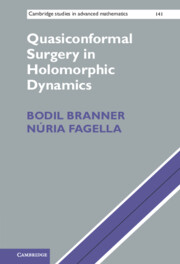Book contents
- Frontmatter
- Dedication
- Contents
- List of contributors
- Preface
- Acknowledgements
- List of symbols
- Introduction
- 1 Quasiconformal geometry
- 2 Boundary behaviour of quasiconformal maps: extensions and interpolations
- 3 Preliminaries on dynamical systems and actions of Kleinian groups
- 4 Introduction to surgery and first occurrences
- 5 General principles of surgery
- 6 Soft surgeries
- 7 Cut and paste surgeries
- 8 Cut and paste surgeries with sectors
- 9 Trans-quasiconformal surgery
- References
- Index
1 - Quasiconformal geometry
Published online by Cambridge University Press: 05 February 2014
- Frontmatter
- Dedication
- Contents
- List of contributors
- Preface
- Acknowledgements
- List of symbols
- Introduction
- 1 Quasiconformal geometry
- 2 Boundary behaviour of quasiconformal maps: extensions and interpolations
- 3 Preliminaries on dynamical systems and actions of Kleinian groups
- 4 Introduction to surgery and first occurrences
- 5 General principles of surgery
- 6 Soft surgeries
- 7 Cut and paste surgeries
- 8 Cut and paste surgeries with sectors
- 9 Trans-quasiconformal surgery
- References
- Index
Summary
Since its introduction in the early 1980s quasiconformal surgery has become a major tool in the development of the theory of holomorphic dynamics.
The goal of this chapter is to collect the basic definitions and results about quasiconformal mappings used in surgery, and those necessary to make a coherent description. We give a geometrical and analytical approach and give precise references to important results in the vast literature about quasiconformal mappings. In general we only prove those we could not find proven elsewhere, even if simple. However, since the Integrability Theorems (Theorems 1.27 and 1.28), also called the Measurable Riemann Mapping Theorems, are the cornerstone behind every surgery construction we sketch a proof of those.
Holomorphic maps are very rigid, due to the property of analytic continuation. For this reason it is not possible to paste different holomorphic maps together along a curve to form a new holomorphic map. However, quasiconformal mappings do have this kind of flexibility and can be pasted together to form new quasiconformal mappings. It is this flexibility that produces the basis for surgery constructions where we change mappings and sometimes also the underlying spaces. When the construction is successful the final goal is to end with a holomorphic map, obtained via the Integrability Theorem.
- Type
- Chapter
- Information
- Quasiconformal Surgery in Holomorphic Dynamics , pp. 7 - 63Publisher: Cambridge University PressPrint publication year: 2014

